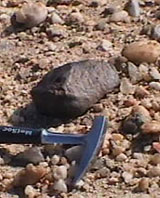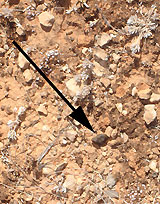Hot desert meteorites
Hot deserts, such as the Nullarbor region of Australia and the Sahara Desert in Africa, are excellent places to find meteorites because they are dry and old.

A Namibian desert meteorite.
Dry environments
Meteorites that fall in places where it rains, such as the UK, disintegrate into soil over about 100 years. Exposure to water causes the metal in meteorites to rust, and silicate to turn into clay.
Because there is little moisture in deserts, the corrosion of meteorites is slower, allowing more meteorites to accumulate.
The oldest meteorites found in hot deserts can have a terrestrial residence age of around 40,000 years.
Old environments
More meteorites can also accumulate in deserts because the surface of the land changes more slowly.

Meteorite found in the Nullabor Desert by one of the Museum's scientists.
All over the world, erosion and the depositing of sediment cause the landscape to change over a few hundred years. This is illustrated by the fact that we often need to dig to find archeological artefacts.
Again, the lack of water means this occurs more slowly in deserts, where the surface can be stable for 20,000 years or more.
The main eroding force in deserts is the wind, and this can actually be beneficial to finding meteorites, as it blows away dust and sand but leaves heavier rock and meteorites.
Even in the best areas of hot deserts, meteorites are still relatively rare with only 2 or 3 meteorites present every square kilometre. Only in a strewn field, where there are numerous stones from the same fall, can meteorites be abundant.
Toolbox

Our fossil insect collection includes Rhyniognatha hirsti, the world's oldest fossil insect, dating back some 400 million years.